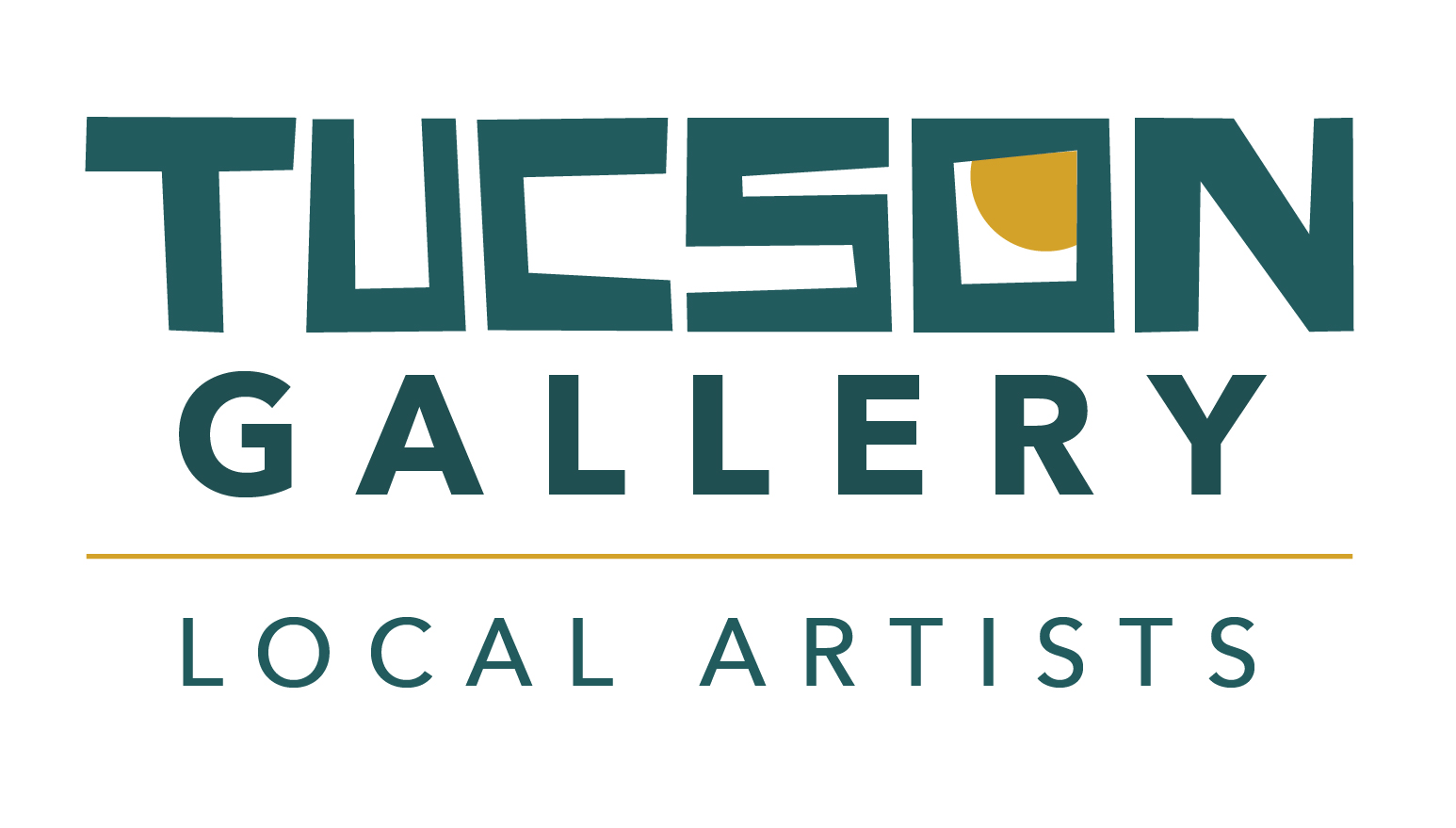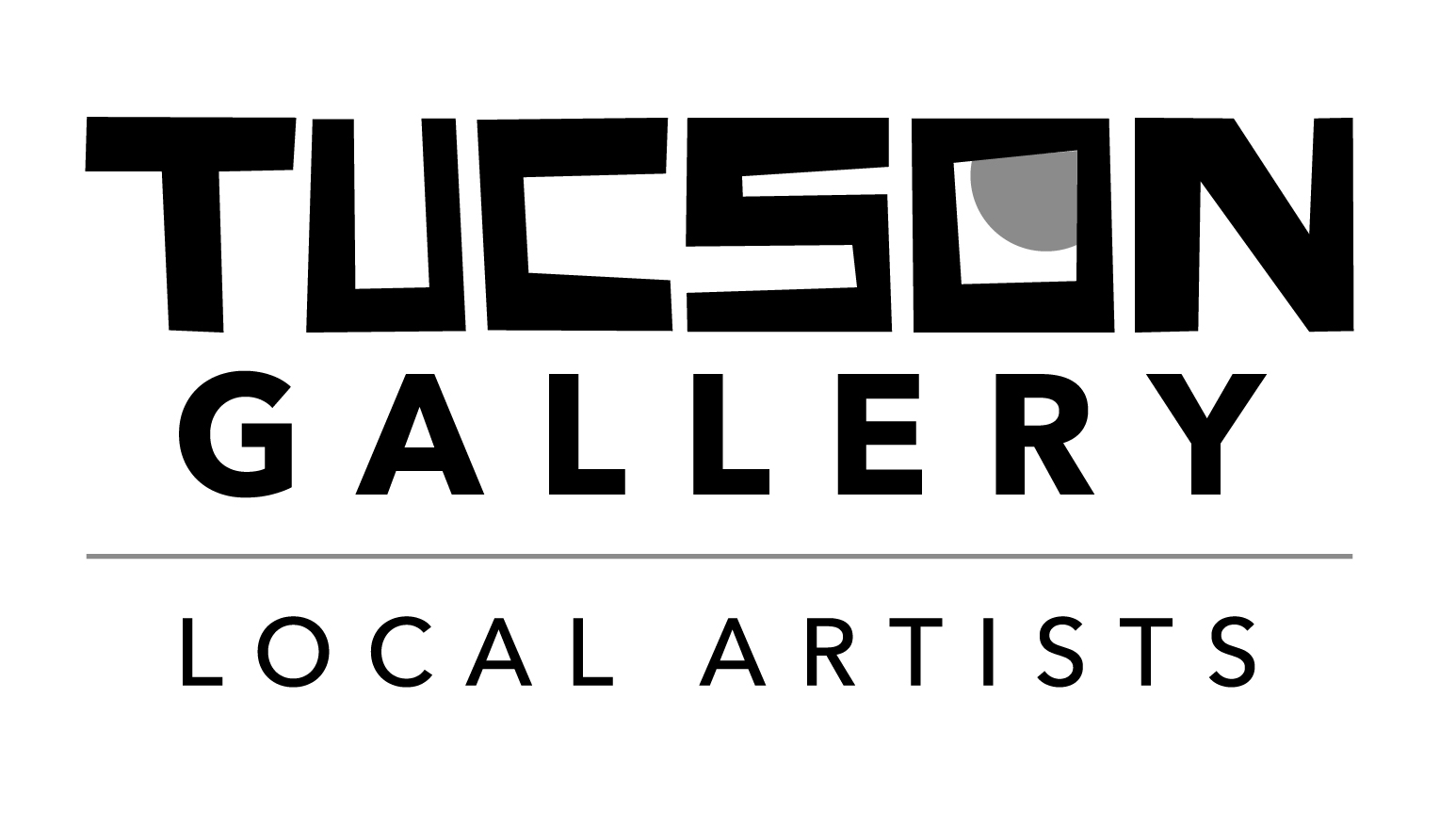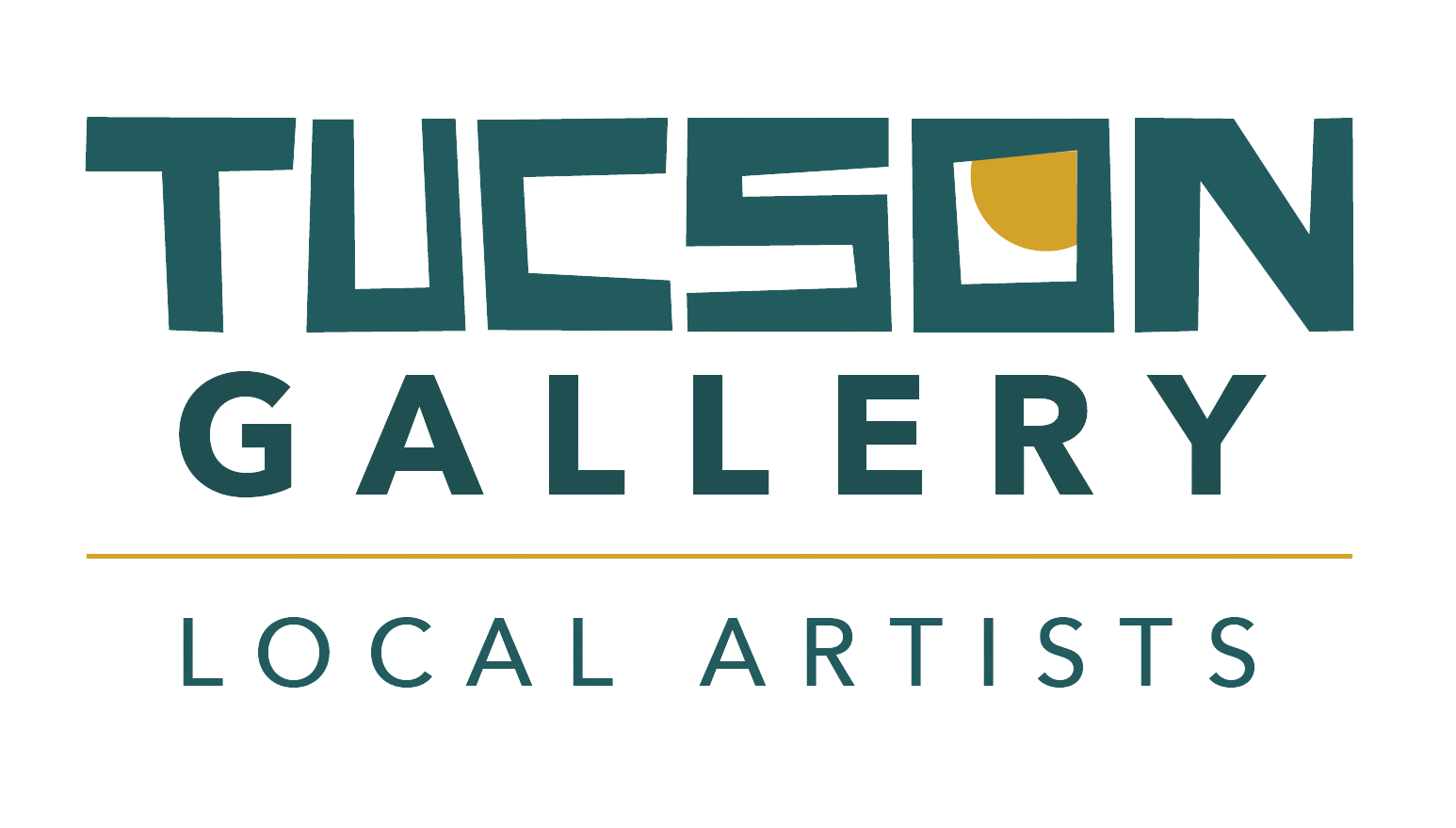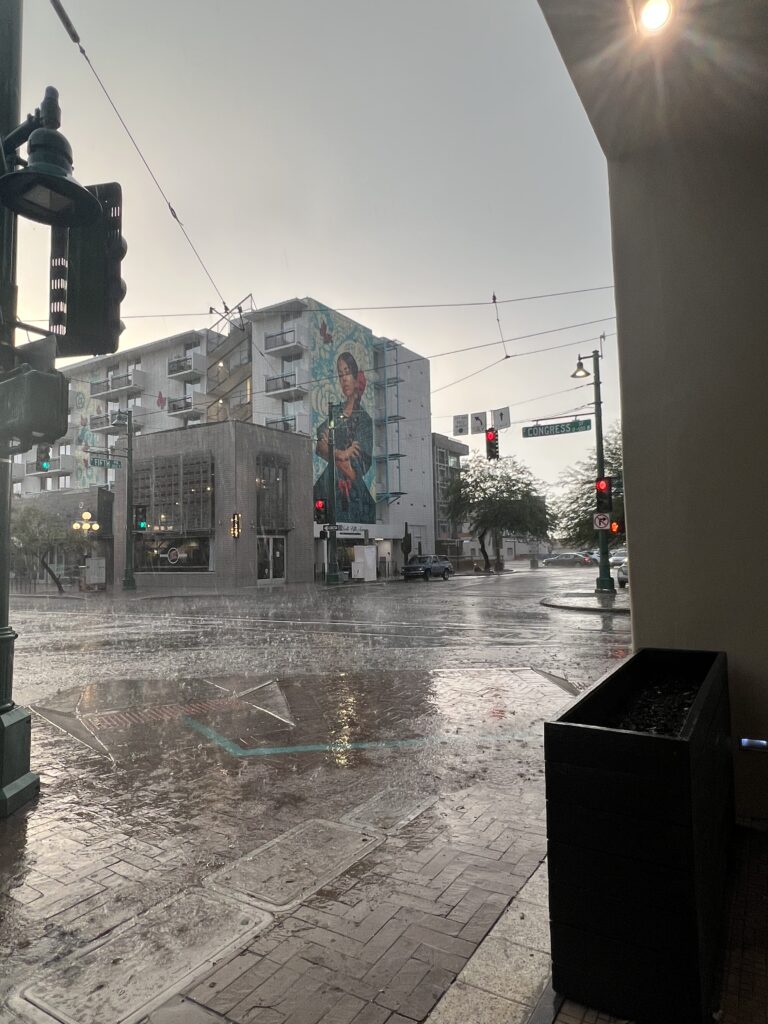
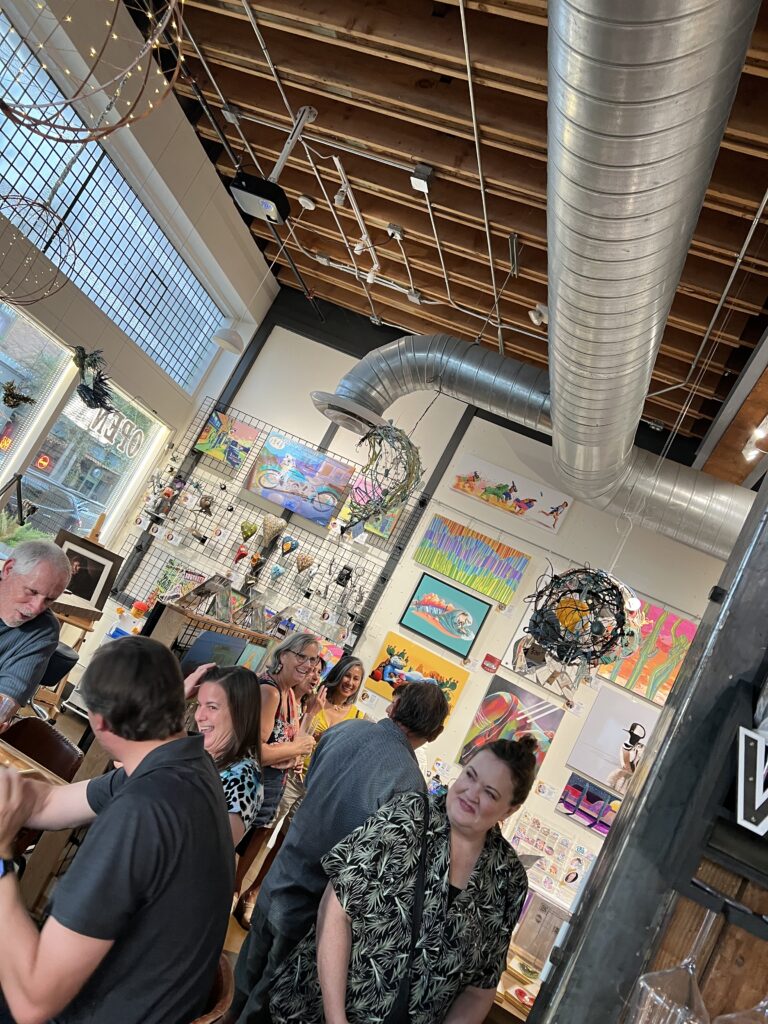
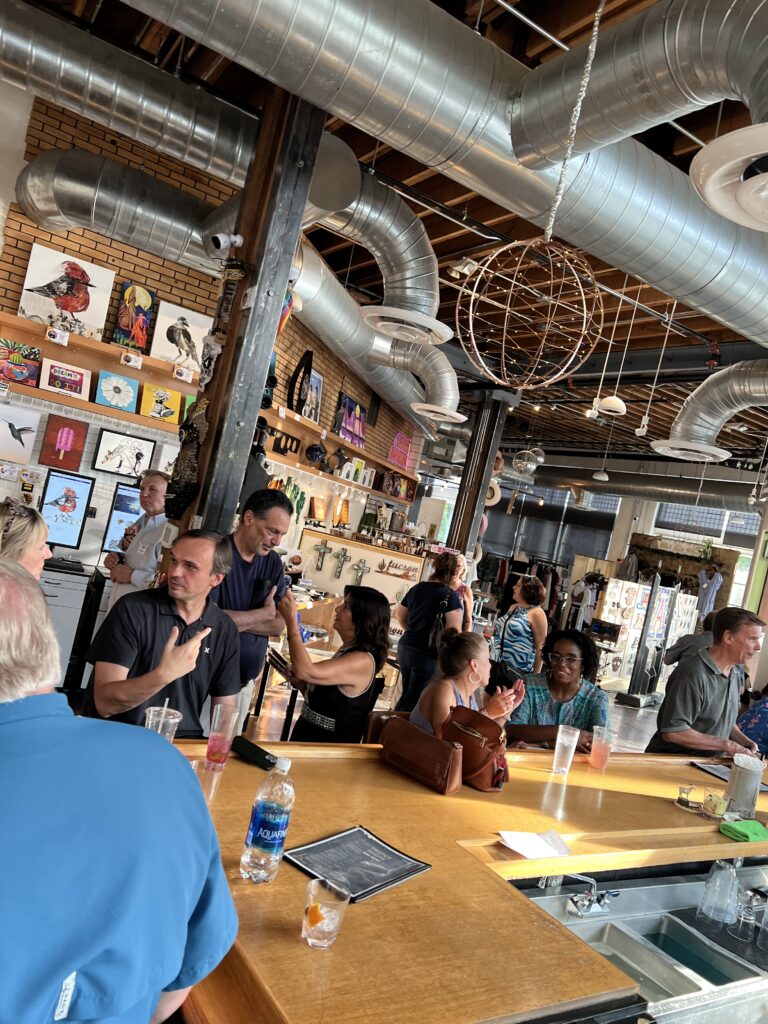
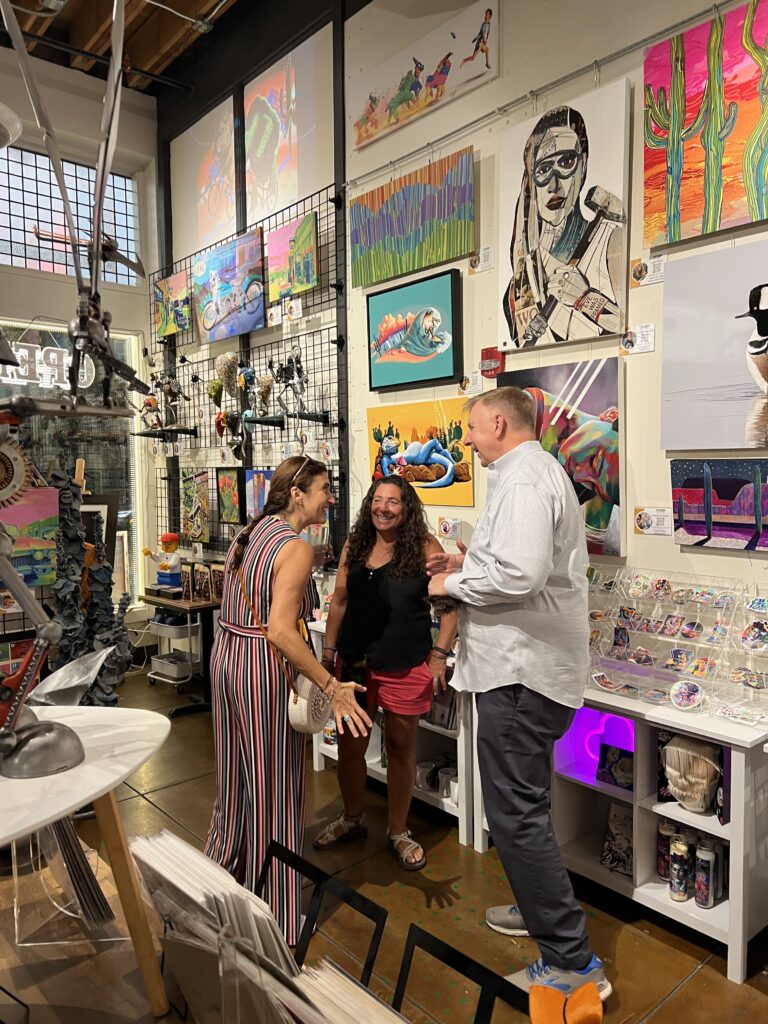
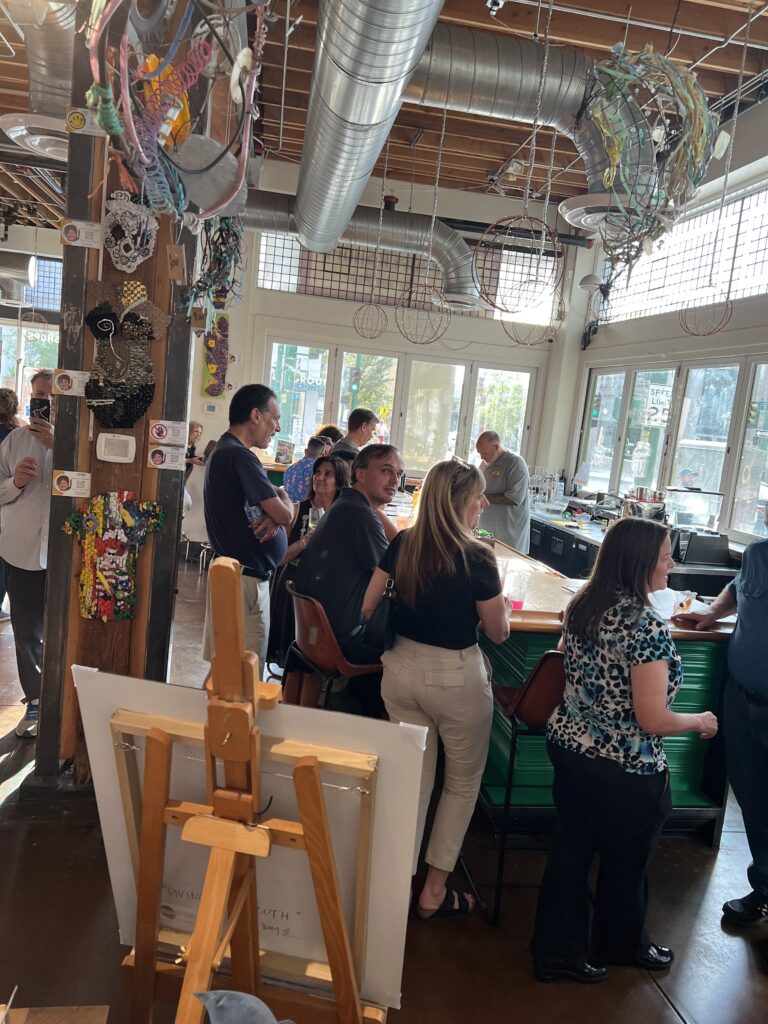
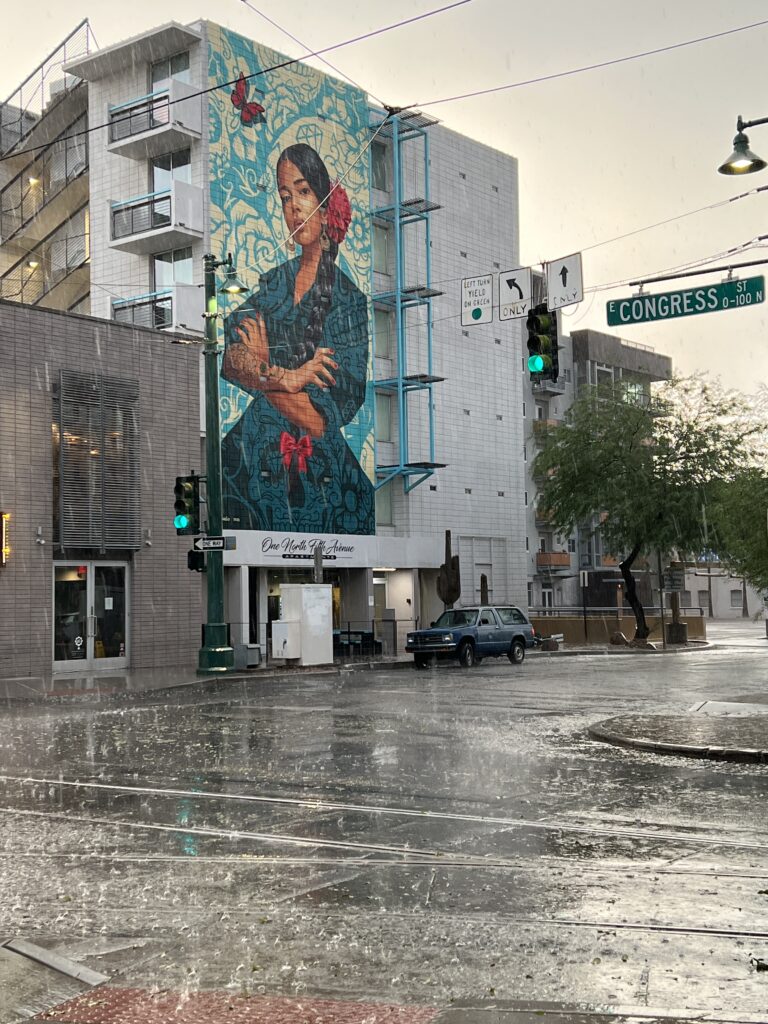
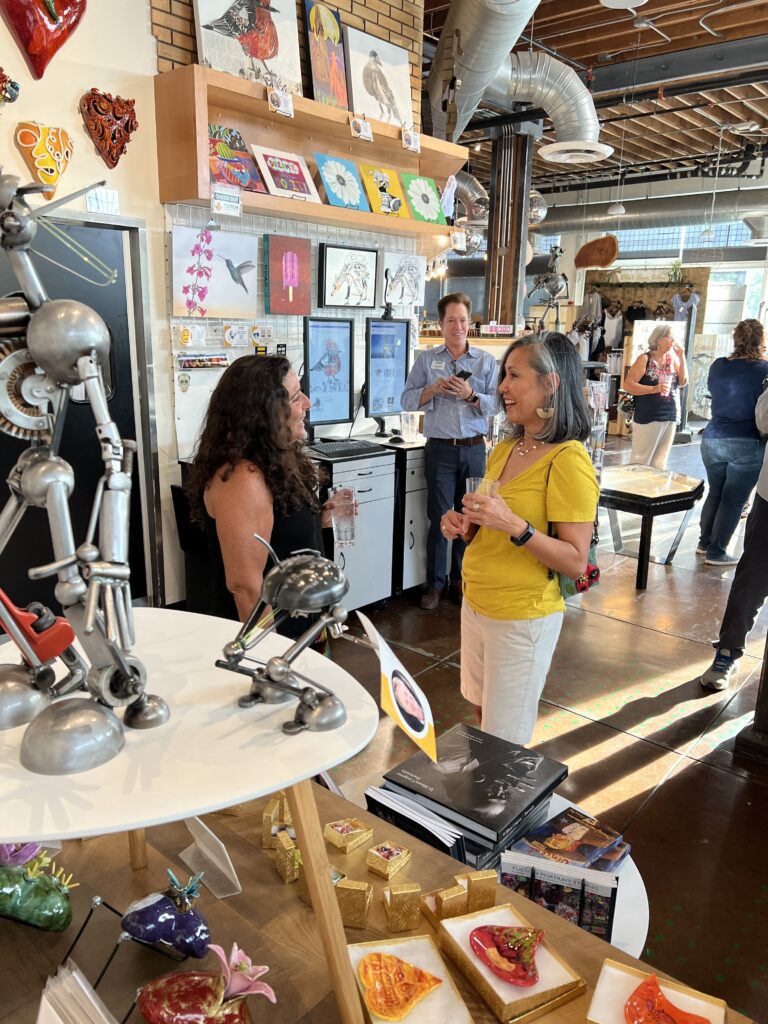
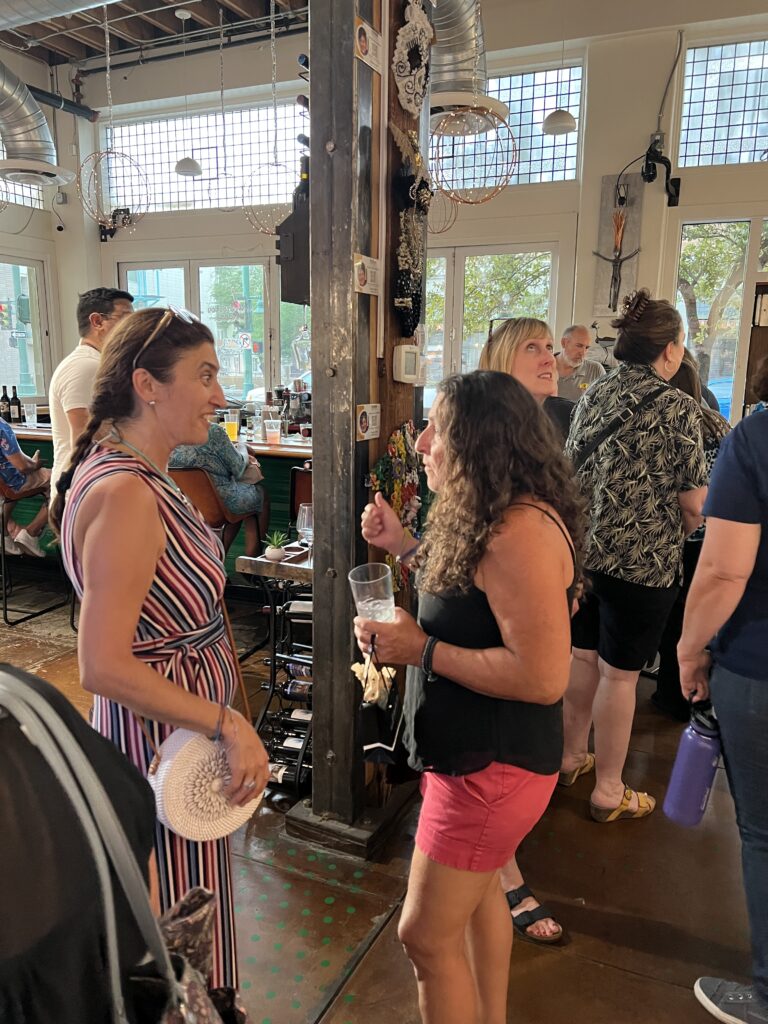
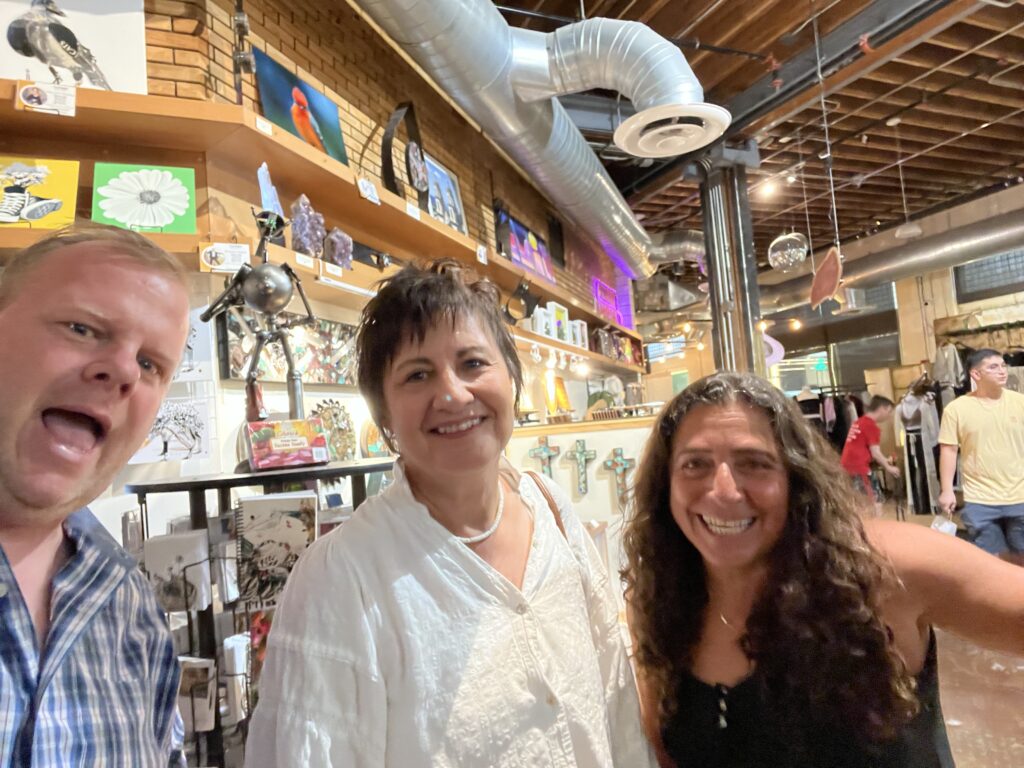
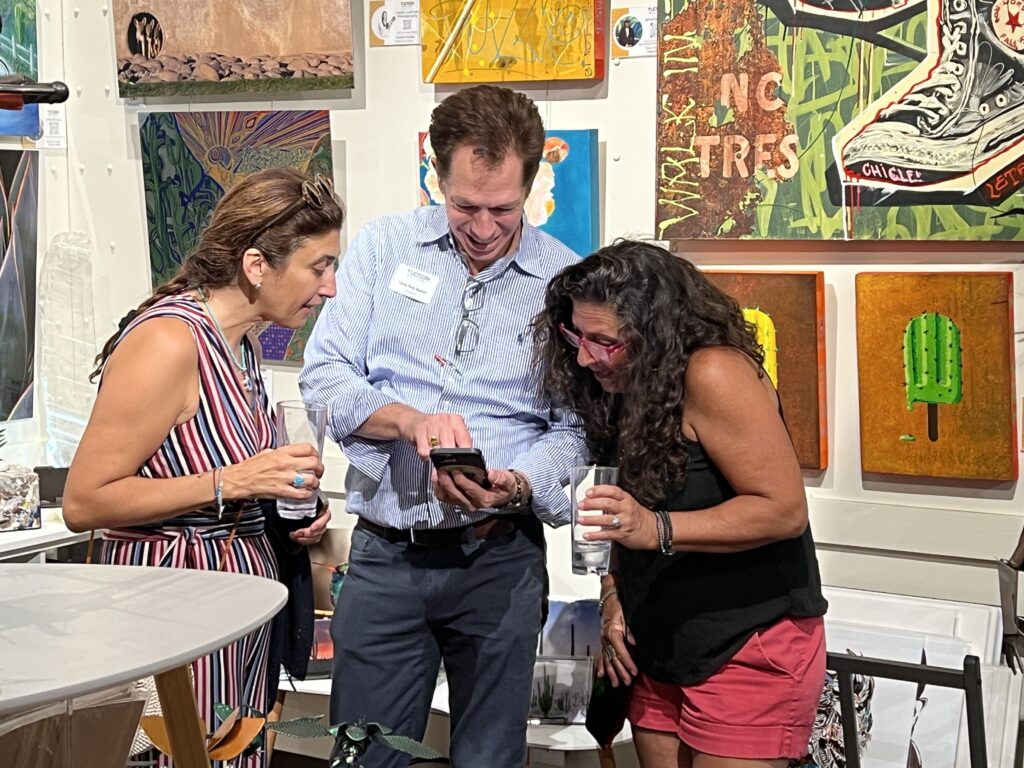










Tom Heath
Welcome back to another raucous Meet the Artist event. We got a big turnout here tonight for our artist, Lisa Agababian. We are at the Tucson Gallery inside of the proper shops at 300 East Congress. It’s in downtown Tucson, across the street from Hotel Congress. We represent about 30 different local artists here in Tucson, and every now and then, we’re lucky enough to get them to come in and meet the public and share a little about their history and their story. And when they do, we steal a little bit of their time and record these Meet the Artist podcasts. If you want to learn more, you can head over to our website, thetucsongallery.com. On there you’ll see the schedule of events as well as past episodes of Meet the Artist. And then you can also see all kinds of merchandise for sale. In some cases, you can buy reproductions. But our artist today, it’s kind of hard to reproduce what she does because it’s all out of ceramics. But, Lisa, welcome to the show here.
Lisa Agababian
Thank you. Glad to be here.
Tom Heath
Yeah, we’re super excited. You got a big crowd here for you. People must like you. I’m going to try to move the microphone just a little bit closer to you there. So I was reading your bio, and I found it very interesting because a lot of the artists that we work with, they’ve come from a creative background. But you were, like, in computer software or computer. What were you doing?
Lisa Agababian
I was a computer consultant for many, many years, and I did a lot of work for nonprofits in Tucson and many, many nonprofits in yeah, but I’ve always had my hands in the clay, so I never felt like the clay is very important to me since I was a young person.
Tom Heath
Okay.
Lisa Agababian
And so even though I didn’t get the encouragement to move in the art direction and I went in a little bit of a different direction as far as my formal education, I always had my hands on the clay. Okay. But, yeah, I’m a techie. I’m a nerd.
Tom Heath
We don’t find too many of the artists that are techies. There’s, like, the left brain, right brain. You got all the whole brain working.
Lisa Agababian
Sometimes one works better than the other.
Tom Heath
At least one of them is working. Sometimes none of mine are working.
Lisa Agababian
I hear you.
Tom Heath
So you’ve always been working with clay. Do you remember what drew you to clay the first time?
Lisa Agababian
Oh, yeah. I was at an Armenian summer camp in upstate New York, and I remember taking a clay class and got my hands in the clay and just felt like this felt like home to me. And although I was interested in a whole lot of other things, I just kept going with it. I ended up becoming a camp counselor in ceramics, and I was there years. I say years, summers, like two months out of the year, but just to.
Tom Heath
Kind of get that bug and then all of a sudden you’re like, okay, now not only do I enjoy it, but I want to teach and train.
Lisa Agababian
Oh, yeah, you want to share your passion with other people because you can get really creative. Not only just throwing on the wheel. I was obsessed with throwing on the wheel as a kid, and I just obsessed with centering clay. But that’s the beginning of everything. Once you get centered, you can go anywhere.
Tom Heath
I think that centering. Then that’s probably like that computer side of you, that everything’s going to be right there. Right. Perfectly centered. And then the artistic side takes over and says, okay, now we’re going to create something.
Lisa Agababian
Now we’re out. Yeah, sky’s the limit.
Tom Heath
That’s beautiful.
Lisa Agababian
But yeah, I always got into it, and I also got into a little bit of sculpting, even though I was obsessed with throwing on the wheel.
Lisa Agababian
The minute you get your hands in the clay, it just kind of takes over. You see things just squishing a piece of clay. But then, like I said, I was obsessed with throwing on the wheel for many years.
Tom Heath
Now. I have to admit, I have a bit of a clay background. I think I made in fourth grade, I made an ashtray for my mom who doesn’t smoke, but that’s all I could figure out. I don’t think it started out as an ashtray. It might have started out as a bowl, but ended up as an ashtray.
Lisa Agababian
That’s so funny. You always keep cutting it down. You keep trimming the lid of the I should say the lip of the piece as you’re working on the wheel or if you’re working with coils, but it’s all so much fun.
Tom Heath
Well, that was the extent of my ceramic background, but I do remember I made it. And my mom was very gracious. Even though she doesn’t smoke, she’s like, we have friends that smoke. So there you go. So you did the corporate world, so to speak, for a while, and are you still doing that or are you an artist full time at this point?
Lisa Agababian
I am an artist full time. Wonderful. I felt like the world I got into was really the nonprofit world.
Tom Heath
Okay.
Lisa Agababian
I was in the corporate world, and that threw me for a loop, and I really didn’t like being in that environment. But once I started working for nonprofits, I felt something more personal with people, and then it just grew from there. And then I always had my hands in the clay. So even as a computer consultant, I’d still be creating and giving things away all the time. And so people always knew me as a clay person, even way back then.
Tom Heath
Yeah, I would imagine if you’re giving it away, they’re probably like wanting to really know you as a play person. But anyway, nowadays they’re not giving it away. Do you remember kind of that time frame like how you transitioned from being employed in one career and then just moving full time to an artist. Were you doing both for a while or did you just one day wake up and say, I’m done with this computer stuff?
Lisa Agababian
Yeah, I’ve always had my hands in the clay because it was part of my sanity and my serenity. And so I just needed that everybody has something where they kind of well, hopefully people have something where they can ground themselves in. Although I did love what I was doing with the computer work too. I just felt at home in the studio and working with clay. Anyway, the transition happened. Really big transition is I had many losses in my life, and I don’t want to go too much down the rabbit hole here because I can, but I had many, many losses in my life.
Lisa Agababian
The first one was the wake up call with my mom. When she passed on, she was here one day and gone the next. That just pulled me out of the water. And even though I was doing working with computers at the time, I just kind of got that message, like, right, be here now. That was the message. If you’re not doing or pursuing or moving slowly in the direction of what you love to do, you’re missing the boat right here, right now. And I got that message of enjoy here now. And then when my dad had passed, that was when I transitioned full time. I was like, my dad was pretty nuts. But anyway, God bless him, he’s like, Are you still working? Are you still working? You’re still making money? But anyways, I think we’re going to.
Tom Heath
Do a podcast just on your dad. Like a whole separate one. It sounds like there’s some good stories.
Lisa Agababian
Yeah, I think so. But anyway, so when he passed, I really kind of went low, and I felt like I was always kind of analytical and I was in my head, and I loved organizing and problem solving and stuff. And then it almost felt like a time where the universe was just taking me from my head to my heart. Literally. It was like I couldn’t think logically anymore. I knew I was going under on some level and that I should just go with the flow. And I feel like I just really made it to my heart. And then after many years, I feel like I’ve integrated both. Although, as you know, I can’t even keep a contact list these days. But I’m definitely into the art, and I do like having exchanges with people, and I do love what I do. And the people that I used to work as a computer consultant for, they all knew my heart was in the clay, too. Although I think I did perform pretty well for them at the time.
Tom Heath
Well, you did it for 20 years, so you don’t do something like that. Not well. You do it well, because otherwise people aren’t going to be hiring you.
Lisa Agababian
Yeah. And this was really, though, following my heart. It was like time. Instead of focusing outward, it was like focus inward. And who is Lisa and what is Lisa doing? And it was like, 50 million other questions of like, and not doing it. What are my interests? What are my passions? And not doing it just to do it for performance or money or kudos. It was almost like I was reborn again, and I was reparent parenting myself all over again and finding your purpose. Yeah.
Tom Heath
This is like life lessons here on Meet the Artist. This is fantastic. We’re going to start selling this as, like, coaching. This is great stuff. We talk to artists about all the time, about finding this passion and driving it, and people get to it to different ways. But this is kind of the first time that I’ve heard someone say, you know what? I forget about what I enjoy doing. Like, what am I supposed to be doing? And it sort of took you in that direction.
Lisa Agababian
Right. And it’s scary to go in that direction, but I had a little light that was just like I was trusting that and just going in the direction. And you never know how things unfold, but we’re all on some kind of journey and unfolding. Right.
Tom Heath
We talked last year and said, hey, I’m going to have a gallery. I don’t think I would be oh, yeah, sure.
Lisa Agababian
That’s right.
Tom Heath
That’ll be the case. Thank you. So we’ve talked a lot about hearts, and if you’re listening, I encourage you to head to our website, thetusongallery.com, and look up Lisa’s profile. You’ll see pictures of what she has in the gallery. And what we carry are just beautiful different sizes. These beautiful hearts with they’re not just ceramic hearts. There’s, like a mixture. You’ve sculpted items on these. But do you do mostly hearts, or is that just what we carry?
Lisa Agababian
No, I should say yes, I do hearts. That’s all I do. Yeah. Today, I mean, I used to throw on the wheel, but today it’s all heart sculptures and everything’s hand built. And it’s so funny. I went from throwing on the wheel as a kid and doing a little sculpting, but this is all hand building, and I love it. I go into a Zen mode and listen to music and podcasts, and I’m in heaven in the studio. For the most part. Everybody has good days and bad days, right? And I love the handbuilding, and I think it’s because I found my purpose. And I feel like something just keeps feeding me, and it’s just like and sometimes I just have to write down if I get an idea or I make a connection between the heart and something else, immediately write it down. Because clay is a major process. It’s not like painting where you just paint, and I don’t want to put down painting at all because I’m amazed at some of the painting.
Tom Heath
We’re going to have a throw down. Now, ceramics, the painters, that’s going to be a fundraiser. Put them in the boxing ring there and see what happens.
Lisa Agababian
No, I have total respect. But also, clay, as you might know, too, is a process. You create a form and then it has to dry.
Tom Heath
From my third grade ashtray, I do remember that process. Yours is probably a little bit more in depth.
Lisa Agababian
Yeah. But whatever you’re creating then has to dry. Then it goes into the kiln. You fire it for first firing. A BISC firing is at least like 12 hours, if not more. Then once it comes out of the kiln, it’s more brittle. It’s not as soft and breakable and porous. But then you go through the whole glazing process and you paint to use colors and stuff, but what you see is not what you get in glazing. And when you’re painting I’ve heard that.
Tom Heath
I’ve heard that from other people, though, because the heat transforms it. So you have to know with enough experience what it’s going to look like when you’re done, because it looks different going on.
Lisa Agababian
Exactly. And there’s a gazillion glazes on the market, and there’s so many ceramics is so vast, and that’s the beauty of it, too. You meet another artist and so different than what I might be doing or somebody else is doing. And there’s high fire and low fire and raccoon. It’s wonderful.
Tom Heath
And I’m going to use the word just, and I don’t want to put anything down. But you don’t do just hearts. Your hearts have so much character to them. And a lot of times there’s like hummingbirds coming out or there’s rivers running through them or there’s a house. First of all, how do you get to that? Does it happen during the creation? Or do you have a vision beforehand and create it?
Lisa Agababian
Sometimes when I have an idea or because I’m having a connection with someone or something, or I’m in nature and I have an idea or whatever, like I said, I have to write it down because then it will manifest later. I have to really prepare to okay, now I’m glazing. Now I’m working with greenware and working with clay. But sometimes I will just get in the studio and just start working on a piece and then it just kind of unfolds, too. So I would have to say, for me, it’s a little bit of both.
Tom Heath
Okay. And then when you’re creating, some of these look like they’re multiple pieces that are put together. When you go through the process, at what point do they come together?
Lisa Agababian
A couple of different ways. Like when I’m working in the greenware stage, when I’m working in wow, it’s getting a little rowdy out there.
Tom Heath
Lee’s got some fans here. We’re going to have to hurry up.
Lisa Agababian
Where was I? In the greenware stage. So in the greenware stage can you explain?
Tom Heath
I don’t know what that okay.
Lisa Agababian
Greenware is when you just take when you’re just getting some clay out of the bag. Okay. And so it’s like straight from the earth, pretty much. And it’s soft and it’s malleable. So you start working with the clay and I just kind of totally lost my traight.
Tom Heath
I was just trying to figure out when the pieces come together.
Lisa Agababian
Okay. So, yeah, I’ll usually work if I’m handbuilding, I make the heart form first, and then if I embellish it with, like if I want a hummingbird coming out or I want roses or lilies or whatever coming out of the piece, then I make those separately. But everything’s got to be consistent as far as the drying goes because I have to pull it all together if I’m doing that in the greenware stage. So I’m connecting the pieces together. So like roses or flowers, any flower just coming out of the piece, I attach the pieces in the greenware stage before I do my first firing.
Tom Heath
So when it comes out of that first firing, it’s already brittle. And these things are so delicate.
Lisa Agababian
That’s right. When you say delicate, I mean they’re more delicate before the firing because at that point well, if it falls in the biscuit stage, you can lose the piece in the greenware stage. It’s very brittle. I mean, it’s very soft.
Tom Heath
Okay. So that could change shape. It doesn’t take much to change the shape because it’s just lean against it and all of a sudden it’s not as hard anymore. It’s a square.
Lisa Agababian
That’s right. Yeah. And then once the piece dries, it’s still fragile. Once goes in the kiln and gets fired to like close to 2000 degrees.
Lisa Agababian
It actually goes through a process of drying. And basically what we call that is vitrification.
Tom Heath
Okay.
Lisa Agababian
And so it loses the water.
Tom Heath
Not only are people here to see her, people are calling. Lisa, this is incredibly popular today. Might be the most popular safety artist podcast we’ve had.
Lisa Agababian
You’re, sweetheart. Thank you. You’re so funny.
Tom Heath
With your passion for this. Do you teach? Are you doing classes? Do you help others with this?
Lisa Agababian
I occasionally teach. If I get a group of people together that want to do something, I will throw something together for them if I have the time. Like if I’m in the middle of doing a solo exhibit or a sculpture festival, I’m in the middle the midst of a lot of shows. I can’t do that, obviously, because I’m in the middle of production and creation. I say production because I make my self care spiral heart ornaments for the holidays and my heart grounding stones and things like that. But even when I’m just creating, you really have to be there. I’m with the clay creating, but occasionally I will throw class. I used to do more classes than I do right now, but I love sharing my passion with others. And I love sharing. Even when people come, maybe even this evening. I love sharing my process too. There’s a couple of secrets I’m not going to share, but for the most part, I pretty much share the whole process.
Tom Heath
I have heard in the ceramics world there are some trade secrets because of how things get put together. Like you said, there’s so many glazes and processes. Once you found one that works, it becomes sort of your style as well.
Lisa Agababian
Right? And I think that’s just how it is for everyone. You find your way and then that’s your way.
Lisa Agababian
I have shared some of the secrets with some people because I’m just that way. But anyways, it’s about the passion. I think it’s really at the end.
Tom Heath
Of the day, I think sometimes seeing other people succeed is almost as rewarding. How do people follow you? Are you on social media? Website. What’s your stuff?
Lisa Agababian
Yeah, I have a website, Fuchsiadesigns.com. And I’m also on Facebook. Everybody tells me I need to be more on the Instagram, but I haven’t kind of gotten too savvy with also, I’m a nature girl, so I really need my nature time or be in the studio. So I do share my pieces on my website. I will share all of my larger pieces on my website. Anytime a piece is finished, I get a photo of it.
Tom Heath
Fuchsiadesigns.com.
Lisa Agababian
Yeah.
Tom Heath
And then is the Facebook the same.
Lisa Agababian
Or is it under your name on Facebook? I have one profile that’s Lisa Agabian and then I have another one which I don’t even know why I started, but it’s Lisa Agabian, ceramic artist. I don’t know what I was thinking. But anyway, so I try to post on both. But if someone friends me as Lisa Agabian, they’ll see all the work.
Tom Heath
Lisa is another one of these fabulous Tucson artists. We are so blessed. When we opened the gallery, a lot of it was to share to the world how lucky we are in Tucson. And this is just another example. And literally the places is filled with people that are here to hear her. Tonight, do a little bit of presentation. If you want to see or you want to hear any of our past episodes, you can go to thetusongallery.com and under the media section. All of those episodes are there. If you find your favorite artist, they probably have a podcast and we have recorded these on video. So we’ll see some videos coming out soon. Just haven’t quite gotten there. Maybe we’ll get the videos out when you get on Instagram.
Lisa Agababian
Yeah, sounds good. I got to do that. That’s kind of funny. I came from the computer world and I’m so like went the other direction.
Tom Heath
I think that your gift to the world is your art. And people can see it in the gallery, they can see it online. The Instagram that’ll come, when the time is right, it will come.
Lisa Agababian
Thank you. Thank you.
Tom Heath
Tom, Lisa, I appreciate your time. Thank you so much.
Tom Heath
Whoo. Thank you for listening to Meet the Artist. This is a weekly production by the Tucson Gallery located inside of the proper shops at 300 East Conga Street in Tucson, Arizona. The mission of the Tucson Gallery is to support local artists by providing a space to show their art, a forum to engage with their audience, a virtual presence to connect with global patrons, an outlet to earn a fair price and an opportunity to hone their business skills. Head over to thetucsongallery.com for more information about our live events, listen to other Meet the Artist podcasts and check out the wide selection of art, gifts and other items created by Tucson’s modern, thought provoking and forward thinking artists.
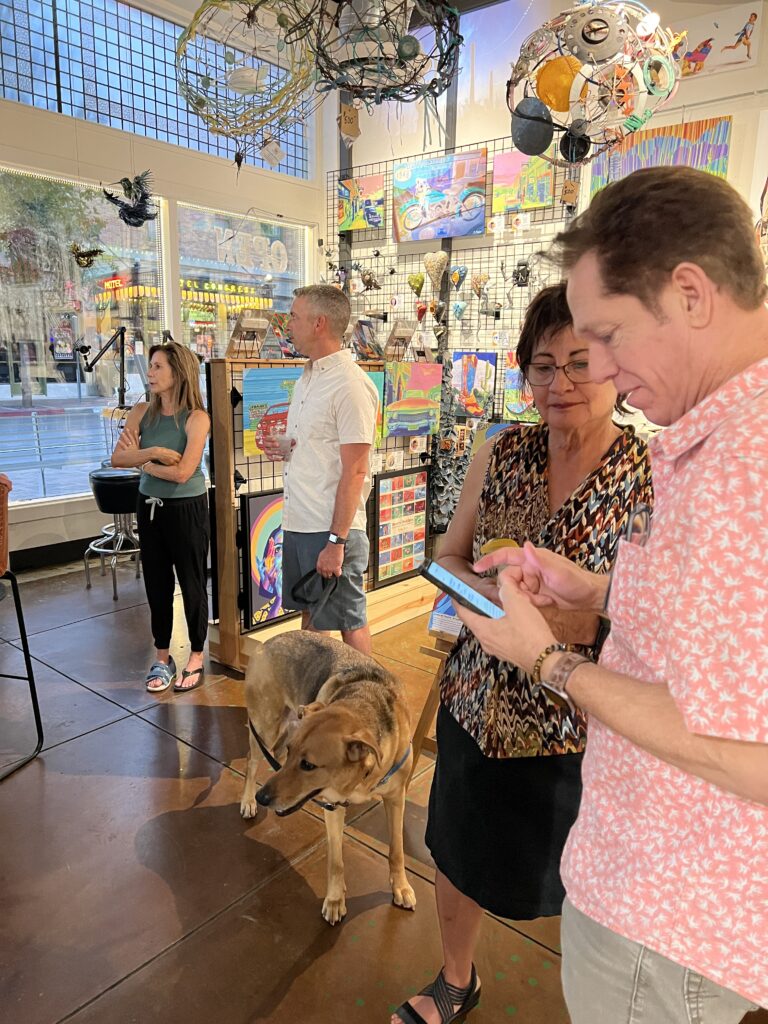
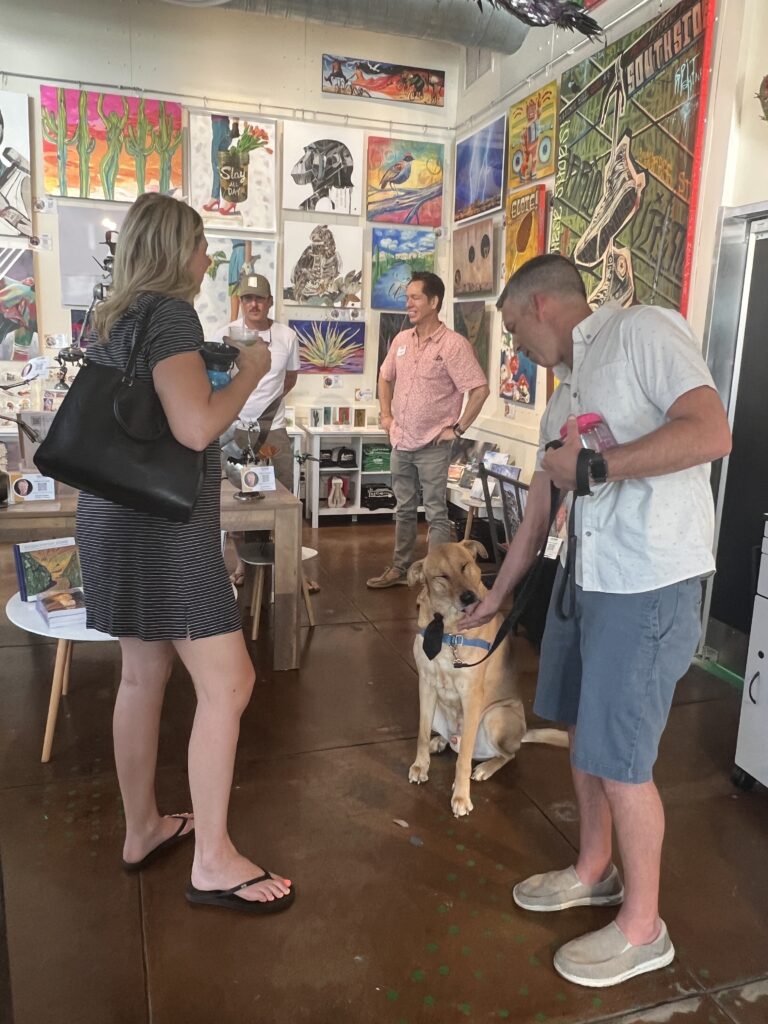
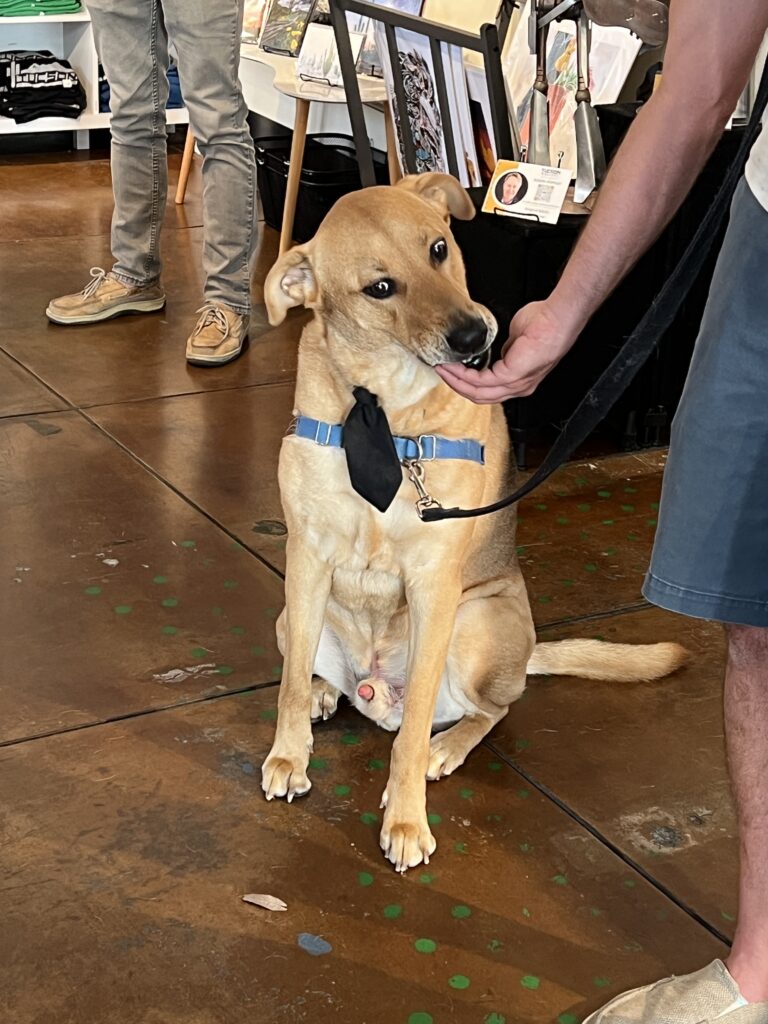
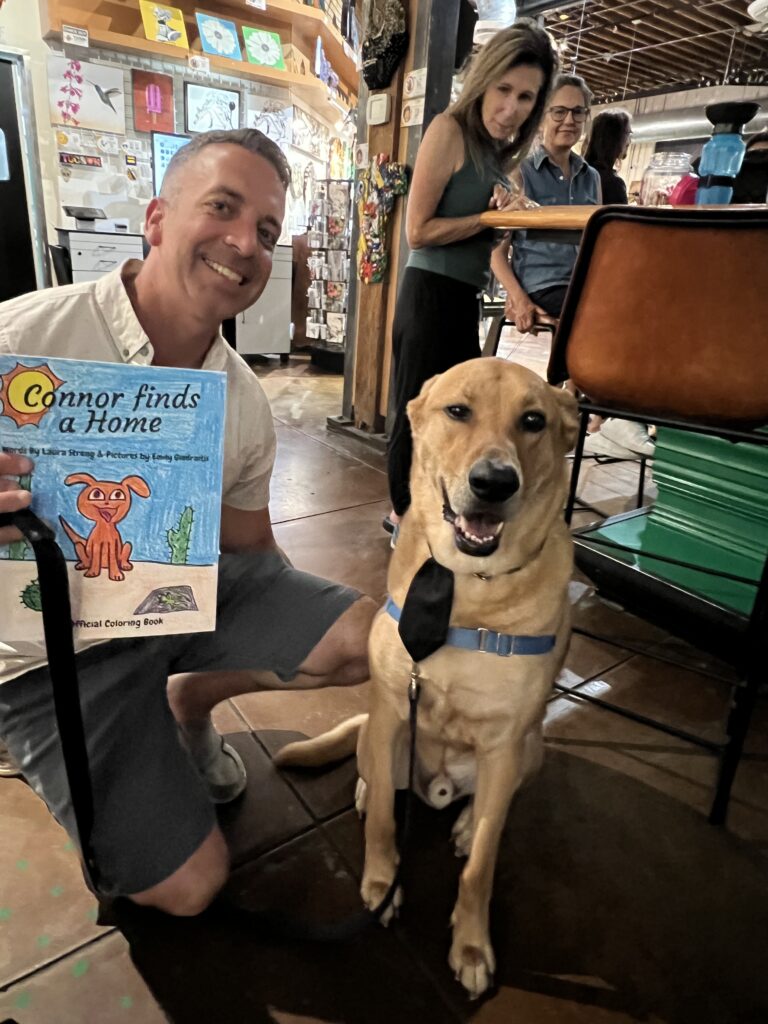
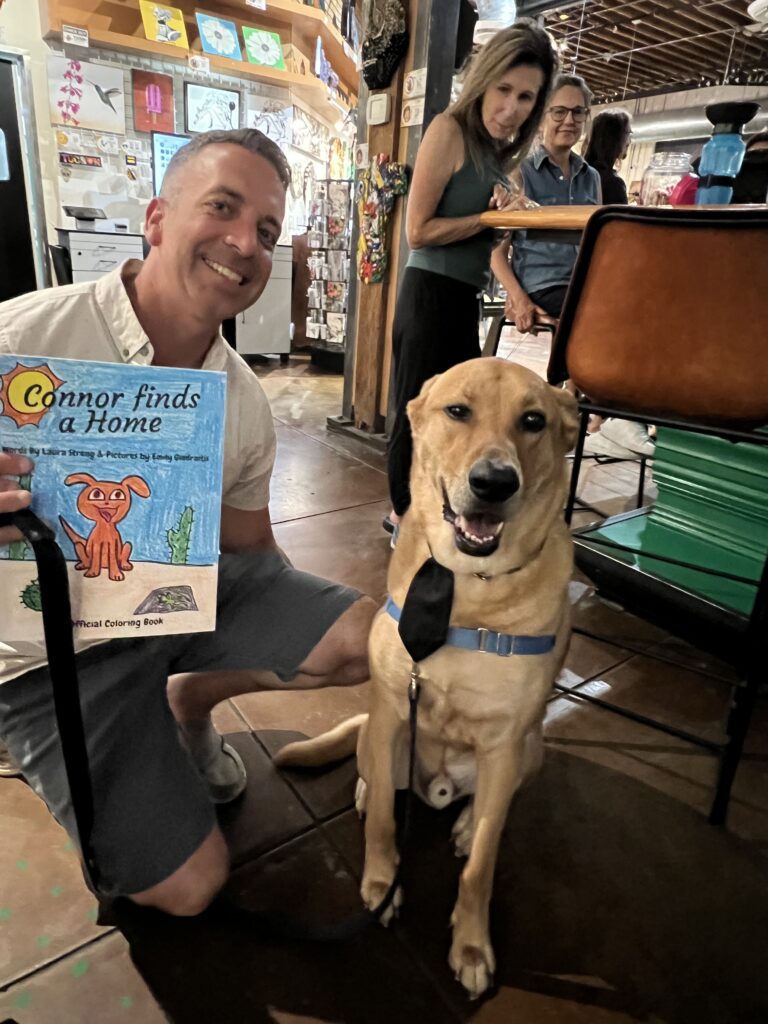
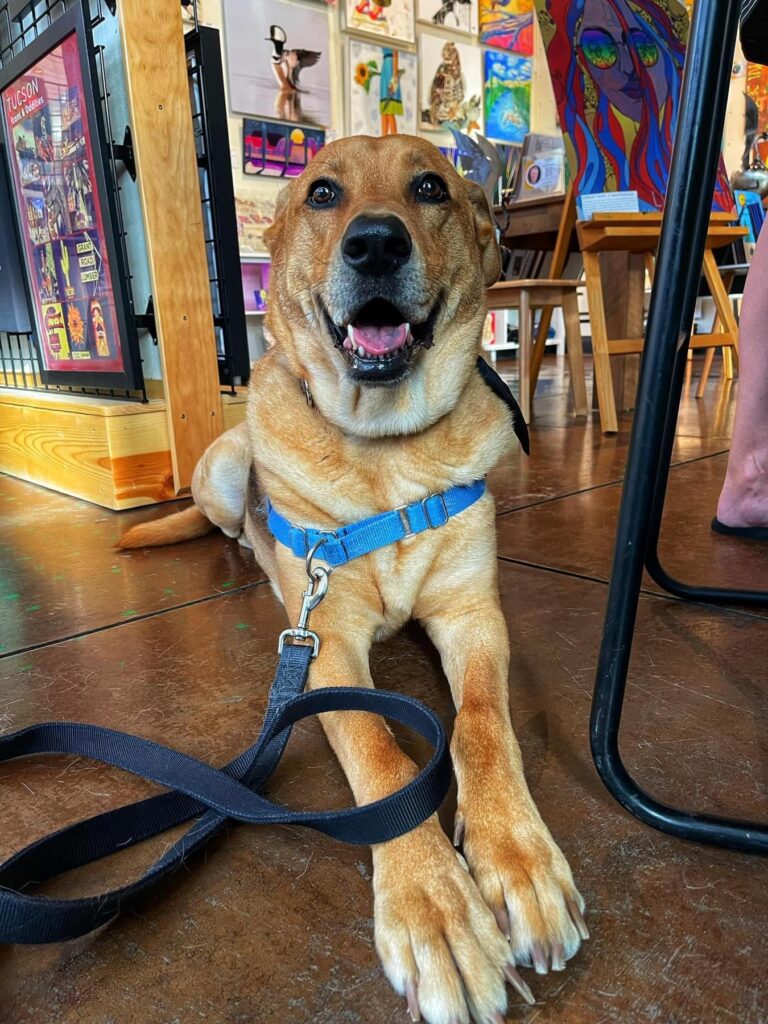
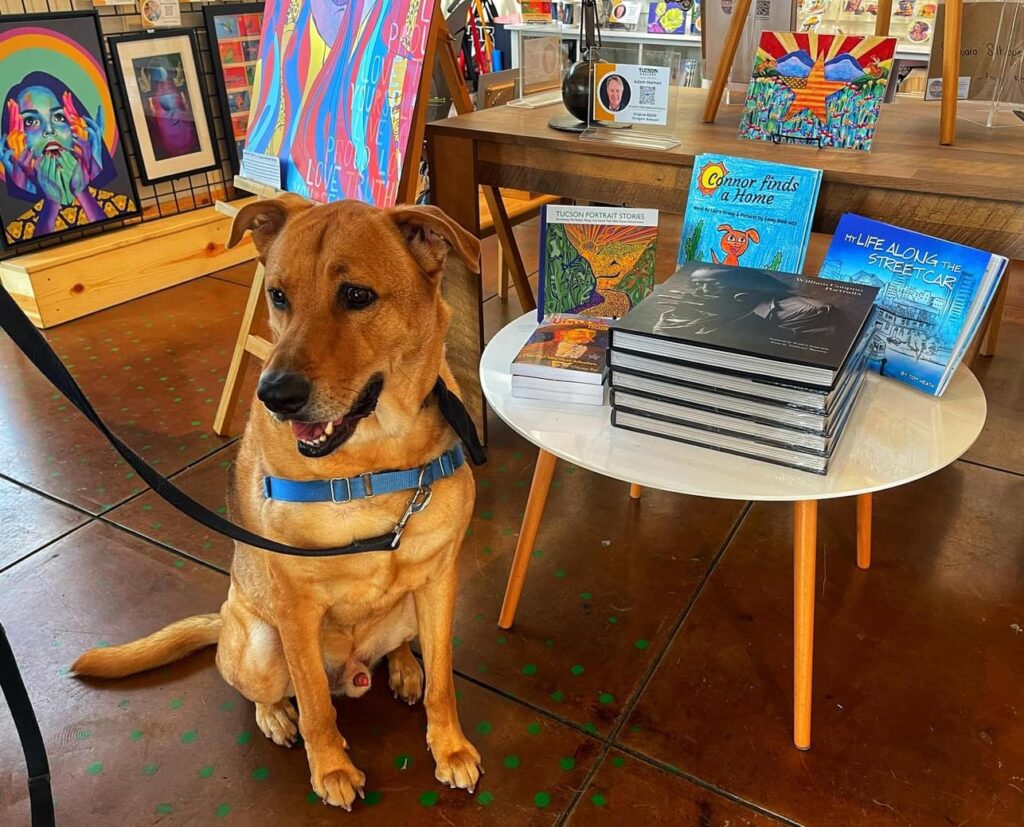
Tom Heath
Welcome back. Once again, we are at the tucson gallery for another installment of meet the artist. It’s a segment we do every time we get one of these fabulous artists to spend a few minutes of their time with us here in the gallery. Today we have a very famous author, laura strang is joining us. And of course, if you ever want to see the past episodes of other artists, you can head over to our website, tucsongallery.com. There’s a section up there of all of our past episodes and there’s a newsletter. Sign up so you can find out when the artists will be live. We’re in the tucson gallery at the proper shops of 300 east congress. We’re right across the street from hotel congress on the same block as the rialto, so we are pretty darn cool. And speaking of pretty darn cool, we have the fabulous laura strange joining us today. Welcome.
Laura Streng
Thank you for having me.
Tom Heath
You’re an artist.
Laura Streng
We’re obligated to have you artist. Maybe not.
Tom Heath
Well, I’m going to have you move down a little bit closer.
Laura Streng
Okay.
Tom Heath
Well, you are an artist. You have taken something that was a passion of yours and you figured out a way to enlighten the world about it. I think that’s what artists do. They enlighten the world about something they’re passionate about.
Laura Streng
Yeah, I would agree. I mean, I’m passionate about dogs and I’m passionate about connor.
Tom Heath
All right, well, let’s talk. So a lot of our artists, they do painting and sculptures and I think when we use the term artist because I’ve written a book. You’ve written a book. And sometimes when they say we’re artists, like, not really, it’s not the same, but I don’t know. You wrote a really cool book. It’s called connor finds a it’s a I understand, it’s kind of a documentary, isn’t it?
Laura Streng
It is a true story. We left out some of the harsher details to make it a children’s book of his initial finding of the home, but it’s all true. It’s all written on him.
Tom Heath
Well, so let’s start at the beginning then. I know I don’t usually like to give away the ending of a book, but this one kind of speaks for itself. So we might be giving the book away. This is not a thriller, but tell us a little about how connor found a home and how that led to the book.
Laura Streng
So connor was we got him from the sanctuary project, which at the time was a fostering program, and he was one of our third or fourth fosters, and he had had kind of a very tragic story. And we got him when he was four months old. And then once he had to go through numerous surgeries and I always just felt like he’s going to feel like he’s so abandoned because he’s in the hospital for weeks on end. So I would go and sit at the hospital and lay next to him and just wanted to see him and be next to him, knowing that I didn’t want him to think he was alone. So that kind of led us to basically make it a foster fail. So Connor found his home because I just couldn’t let him go. And Trevor knew how much I loved we just we made him a home in our home.
Tom Heath
Wasn’t there some other homes that he was a part of?
Laura Streng
He had a few other foster families before he came to us. And for some reason he wasn’t able to be adopted at that time because he didn’t have his surgeries done. So we had to wait for his surgeries to be done. So, yeah, for some reason we just got lucky enough to get him one time and fell in love with him and that was it.
Tom Heath
So he goes from being concerned he’s going to be left alone to I think I’m home, I’ve got my people.
Tom Heath
It’s a story, and we hear that story often, thankfully, that dogs get adopted, but somehow this turned into a so what, what kind of led you to do the book?
Laura Streng
So the book was actually initially started as more of a passion project for Trevor. Trevor really loves doing this sort of thing, and I got into it because he was like, I just like the way that you write. And I like this. And I was, okay, like, let’s figure this out. So we did, and then we got Emily involved, who is our illustrator, and she is fantastic. That is one thing that I cannot do, is I cannot draw. But Emily has a gift.
Tom Heath
Let’s talk a little bit about Emily because she does have a gift. She’s a very special individual, and she loves Connor as well. And she’s your neighbor.
Laura Streng
No. So her dad and I have worked together for ten years.
Tom Heath
Okay.
Laura Streng
Yes.
Tom Heath
Okay. I’ve been telling people she’s your neighbor. So if you bought a book and I told you he was your neighbor, then sorry about that. But there was a relationship. And she loves Connor.
Laura Streng
Yes, she loves all dogs. She loves all animals. Actually, her birthday is today. She’s turning 22 today. And she’s autistic, and she is amazing at art and she loves animals. So she works at the keno school some days and she helps in their farm and all that kind of thing. And she’s incredible.
Tom Heath
And she started drawing pictures, I guess, of Connor, and that’s kind of where sort of this idea to marry the story with her illustrations came from.
Laura Streng
Yeah. So anytime I was sick or one of the dogs were sick, I would talk to her dad at work and he would be like, oh, I’m so sorry to hear that. And then the next day, I’d have this cute little card drawn from Emily, and it was pictures of the dogs. And I was like, god, these pictures are so heartwarming, and just kind like, you look at the pictures, and they’re kind I don’t know if you can describe it that way, but they are.
Tom Heath
There’s definitely a positive energy of every character that she draws. There’s definitely this sense of happiness that comes from them. They’re smiling and big eyes and usually a tongue hanging out. And for the dogs.
Laura Streng
Yes. Yes.
Tom Heath
So then you decided, so Trevor, your husband, he’s like, hey, I got this great idea. I’m going to write a book. I just need to help a little bit. And then all of a sudden, you’re like, you know what? I’m taking over. I’m doing this. You’re out. Was this like a hostile takeover? It was like, what’s going on? You took my book.
Laura Streng
No, he actually was all for it. He did everything else, though, I can say that, literally wrote the story. However, he put it all together and put it on Amazon and did everything that he needed to do in that regard.
Tom Heath
Your producer, your publisher, he’s the guy that makes it all happen. Yeah, which is good because you need the talent to write, you need the talent to draw, and you need the talent to get it up and out to the world.
Laura Streng
It was a collaborative effort.
Tom Heath
Okay. And how long did it take you to write the story? Did it just pour out of you, or did you keep going back and rewriting?
Laura Streng
It initially just poured out of me because I know it so well. It’s our know there was no writer’s block, as most people would have, but this is a true story, so it just came very naturally because it was our life.
Tom Heath
And then how did Emily illustrate? She because the book is so well laid out with a chunk of the story and a perfect illustration. So did that all happen naturally?
Laura Streng
So basically what we did was we printed out the words and then printed out what we wanted on each page, and then we would give them to Emily and say, this is what we want, and some sort of direction as far as, like, we want Connor with a bowl, or we want this. And she just took it and ran with it. And she was amazing.
Tom Heath
There’s many illustrations, and my favorite is that moment when Connor comes home and there’s balloons and a welcome home sign, and he’s like, what is all this partying for? What’s the celebration for? And I still get, like, goosebumps thinking about that moment because it’s so well drawn, it’s so beautiful. The words are perfect. So that page, I mean, I’m a grown man, like, getting goosebumps over a little children’s book, so it might be made for more than just children.
Laura Streng
Well, that’s nice. I hope it is. I feel like the story is made for more than just children.
Tom Heath
And so you’ve kind of taken this. Now, your primary profession is not as an author, as I understand it.
Laura Streng
Correct.
Tom Heath
So the proceeds you’re getting from this. I know you’re donating a lot of them back to local charities, but you’re also taking this opportunity then to spread the story about fostering and adopting, and you’re doing it in a sneaky way because you’re like, reading this story to people, like, oh, it’s story time. But then you’re subtly putting in a message in there that’s kind of sneaky.
Laura Streng
Yeah. Now that school is out, we haven’t been doing it, but once school gets back in, in a few weeks, we’ve been going to some schools and reading to the kids, and I think that there’s no better way than to start early so they know the benefits of this and being able to serve your community.
Tom Heath
And then they go home and they’re like, hey, mom. Hey, dad, guess what? And you’re like, I don’t know where they got that from. Story time. And I love the marketing and this may have been Trevor’s, but I love the marketing that you have a storybook that’s been fully colored by Emily with her vision, but then you’ve also created a coloring book that allows people to be more interactive and create their own color vision for how the story turns out.
Laura Streng
Yeah, we thought that it would be nice because some kids maybe are getting this book and they can’t read, so why not let them illustrate it themselves? As far as the colors that they want the dog to be? Maybe their dog is black. Maybe they want their dog to be know, who knows? But then they can kind of customize it for themselves.
Tom Heath
And let’s talk about Connor. Has this all gone to his mean? He came in for the Meet the Artist night. He’s wearing a tie. He’s a little standoffish. He’s like, you know, do you have treats? I’m not talking to you if you don’t have treats. I’m famous.
Laura Streng
Yeah, he’s kind of a big deal. I mean, in our house, he is a big deal.
Tom Heath
He’s a big dog, so he’s a big deal in any house.
Laura Streng
That’s true. We don’t have his best friend, which is our Nala. That’s his tried and true best friend with us. Otherwise he would be right next to her.
Tom Heath
And Nala is the size of, like, three peanuts.
Laura Streng
No, that’s karma.
Tom Heath
Karma. Oh, okay.
Laura Streng
Nala is the pit bull mix. So she’s like a medium sized gotcha. Yeah.
Tom Heath
And you have three dogs total for the moment, because that’s what I had this morning. But with you and Trevor, I never know this afternoon.
Laura Streng
Let’s hope we stay at three for a little while. They get expensive.
Tom Heath
I understand that. And then can you talk just a little bit about the message of the book? And obviously it’s a pretty clear story about fostering and adopting, but the services that are out there that you support, that are doing things the right way, that need help from others, I feel.
Laura Streng
Like there are so many as far as that need help, I feel like they all do at this point. I mean, you can even look at Pack and they need help. There’s always a need. You got to spay and neuter your pets. That’s just the end of it. We have over 400 right now, I think, at Pack, but on Facebook, 400.
Tom Heath
Animals or 400 dogs. Oh, my gosh, yes.
Laura Streng
So I think that just from the smallest thing or even we were involved with a foster.
Tom Heath
Like a group of people that get together.
Laura Streng
It was a collective. It was a nonprofit. It was a nonprofit. It’s like a cult. Yeah, we all love dogs and we just do everything we can.
Tom Heath
Some leader blindly just crazy. Now I have three.
Laura Streng
But there is plenty of fostering opportunities. Even if you cannot keep a dog, you can always foster with the pandemic. There was a ton of people that were bringing in dogs.
Tom Heath
As far as fostering, have you fostered successfully? Other dogs?
Laura Streng
We have.
Tom Heath
And what’s that process like that. How long do you have them?
Laura Streng
It depends. So it depends on first the dog’s needs. If it’s a dog that needs surgery, then obviously you’re going to have them a little bit longer. If it is a dog that is literally just waiting for its perfect match, then it could be a couple weeks, it could be a month. You never know. We had one before Connor and it was a black lab. His name was Harley. And when we gave him back, everybody’s like, oh, God, how do you do you how do you give them back? And I’m like, well, it’s not giving them back. It’s giving them to a family that you know is going to love and always keep them and safe and just adore them. So yes, it is hard. And yes, we cried. Trevor and I both cried our eyes out when we gave Harley back, but we knew he was going to a family that would be there for him forever. So in that regard, when you’re fostering, you know that that family has been checked out and you know that they’re going to love that dog forever. So that makes it a lot easier.
Tom Heath
Do you ever get a chance to see Harley or do you ever stalk him at the dog park?
Laura Streng
No, I wish I did, though. I’ve tried to find him on Facebook.
Tom Heath
So you’re not connected with the family then?
Laura Streng
No.
Tom Heath
You’re working through an agency. They say, hey, it’s time we’ve got a family for Harley. You cry for a while, give some hugs and kisses and treats, and then Harley goes and you don’t know ultimately.
Laura Streng
Where Harley ends up. Right. But you do know that they have gone through an application process. It’s not just like, here, have the dog. So I know that they’re going to a great family, but I may or may not know the if because I.
Tom Heath
Know for the human side of things, there’s services where you can put your name out there and say, hey, I’m adopted. And people can say, well, I put up a child for adoption. And sometimes they meet through this service. I wonder if there’s anything for the foster, the dog fostering world. Or you can put out there and say, hey, foster these dogs.
Laura Streng
That’d be great because I’d love to.
Tom Heath
See that there, you can so now Connor finds a home, we’re going to write another book about how Connor reunites with Harley. That’s going to be the sequel.
Laura Streng
Gosh, we’ve got plenty of sequels, I’m sure, in Trevor’s brain.
Tom Heath
Yeah, I don’t doubt that. And the love that you have and the care that you take for the pups, and it’s phenomenal. And we love selling the book in the gallery because it is a true story. It’s a Tucson story. It’s a story that a lot of people are familiar with, but the art really brings it home. The words, the illustrations, of course, but just that the way it’s put together. It’s called Connor finds a home. I know you had a website or do you have a website?
Laura Streng
Yeah, it’s Connorfinesahome.com.
Tom Heath
Okay. And then I know their social media, they can follow you on Instagram, on.
Laura Streng
Facebook, and Connor finds a Home.
Tom Heath
That’s pretty hard to track down.
Laura Streng
You’re right.
Tom Heath
And where else are there other places selling the book? Like, can they get them at any does Pack have any no, not yet. They can buy them on Amazon exclusive at the gallery.
Laura Streng
Yes, yes.
Tom Heath
Connor finds a home. And we’re lucky enough to have Connor visiting us tonight as part of the meet the artist event. So we get to meet the artist and the subject. He has not told us yet whether he’s signing autographs, but we’re hoping he’ll see to signing a couple.
Laura Streng
I’m sure he’ll be okay with that.
Tom Heath
And on the website there’s information about the book, but also the true pictures of Connor and all of that.
Laura Streng
It’s also on the back of the book, too.
Tom Heath
Okay.
Laura Streng
Because a lot of kids like that to see the actual pictures of the dog.
Tom Heath
And again, it’s not just kids. I talk to adults and they look this and I show them the back and I’m like, this is a true story. And I show them your photo and that’s Connor. And then they read your bio and then Emily’s bio, and they just fall in love with this, for it is a true passion project. And you’ve knocked it out of the park.
Laura Streng
Thank you. We really love it.
Tom Heath
Well, Laura is one of these fabulous artists that we get to talk to and interact with down here at the Tucson gallery. Just about every week we have an artist that will grace us with their time and they do a meet the artist event. They’re typically on Fridays from six to 08:00 p.m.. If you head over to our website, thetucsongallery.com, there is a calendar of events and a newsletter that comes out once a month that you can sign up to receive and get notifications of the artist. Events, VIP events, special nights, music. We recently did a pop up which was really well received and all that information will get sent to you via that newsletter. And I think probably the biggest thing though is knowing when these artists are going to be in the gallery live and you have a chance to interact with them. Laura, I really appreciate your time and appreciate your effort to put to the.
Laura Streng
Other Connor story well, thank you for having us.
Tom Heath
Thank you for listening to Meet the Artist this is a weekly production by the Tucson Gallery located inside of the proper shops at 300 East Conga Street in Tucson, Arizona. The mission of the Tucson Gallery is to support local artists by providing a space to show their art, a forum to engage with their audience, a virtual presence to connect with global patrons, an outlet to earn a fair price and an opportunity to hone their business skills. Head over to Thetucsongallery.com for more information about our live events. Listen to other Meet the Artist podcasts and check out the wide selection of art, gifts and other items created by Tucson’s modern, thought provoking and forward thinking artists.
Tom Heath
Welcome back to the Tucson Gallery meet the artist event. Every week we have a different artist coming to the studio. They share all their trade secrets. They meet with their fans, sign autographs, all the cool stuff that happens inside the Tucson Gallery, the proper shops, 300 East Congress in downtown Tucson. And then we always pull them away from their fans for a few minutes and record these annoying podcasts because they’re so engrossed. And I’m like, hey, come and come talk to me. And I have to have a podcast, otherwise they wouldn’t talk to me. We appreciate that, but you can’t miss us. We’re in downtown Tucson, across from Hotel Congress, next to the Alto Theater and next to the playground. So come down, check us out, and if you can’t make it down, check out our website, thetucsongallery.com. It’ll have a schedule of all the live events, all of our artists with profiles, those that have merchandise available online, and past episodes of Meet the Artist. Today we have a sculptor in
Tom Heath
our midst. We have the fabulous hopefully I’ll say this right, Ukiah Hoy, you got it. Look at that.
Ukiah Hoy
Thanks. Nice to be here.
Tom Heath
So you like to play with metal is what I understand.
Ukiah Hoy
Yeah, I think play would be the operative word. Right. I like to see where it goes and what I can make it do.
Tom Heath
How did you get started in that? Have you always been like, an artist or did you just wake up one day and say, I want to cut strips of metal?
Ukiah Hoy
I’ve been making art of all kinds since I was little, since I was a small child. My father, his dad was an animator for Walt Disney.
Tom Heath
Oh, wow. So you got some professional artistic blood in the family.
Ukiah Hoy
Exactly. So I used to sketch and doodle and give him my sketchbooks and wait, worryingly for him to meander them and critique them. I always thought I would keep it as just a side hobby. So when I started pursuing art in college, I didn’t really think of where I wanted it to go. And then I stumbled upon metal for one sculpture project there. And I knew in the back of my mind I was interested in metal sculpture. And it really made me angry and it was hard to navigate, but the outcome was really cool. And by the time I was done, I triumphed. And I thought, wow, I could really go somewhere with it.
Tom Heath
What was your first piece?
Ukiah Hoy
There were these two really cool great blue herons that were made in the same way I do all of my birds. And I kind of started out with all of the scrap metal and knew that I wanted to make herons because I had just had a heron eat all my koi out of my pond. That made me very angry and also inspired me.
Tom Heath
There’s a lot of anger in your art.
Ukiah Hoy
I know there’s sharp objects too. Maybe it’s correlated.
Tom Heath
So these heron eat your fish and you’re like, I’m going to sculpt you out of metal.
Ukiah Hoy
Yeah. Instead of like, shooting the bird and stuffing it. The koi were like, ten years old. That’s an investment if you’re a koi person.
Tom Heath
I am not. But a fish that’s ten years old of any sort seems like quite an investment of time and money.
Ukiah Hoy
Yeah. And the birds are protected, so what are you going to do? And they’re beautiful and majestic and fantastic and amazing.
Tom Heath
So did you make herons and then break them? Is that why you made them, so that you could take them down a pain?
Ukiah Hoy
I fell in love with them.
Tom Heath
Okay.
Ukiah Hoy
And so as I’m sculpting with metal, I was learning about what it does. So it heats and it shrinks and that makes it move. And the way I weld is tack welding from the bottom all the way to the top. So by the time I got done, these creatures had this really inquisitive kind of look to their faces and these personas, they felt very alive. And I used them for a show as a senior in college and now they adorn my pond at home, hopefully keeping herons away.
Tom Heath
Wow, that calls full circle.
Ukiah Hoy
Yeah. It was humble, though. I kind of kept them in my pocket and I didn’t make anything like that for a while. And my art degree was focused on art education because I wasn’t really sure what I wanted to do as an artist.
Tom Heath
Okay, before we get into the art education, which we want to talk about, people can see that on our website, thetucsongallery.com but a lot of what you have in the gallery are birds. And is that still your primary sort of object that you create?
Ukiah Hoy
I think currently, yeah, that’s primarily what I’m creating, but I’m interested in how things are assembled, like how the way I’m creating is going to complement what the structure is. So I also enjoy insects for the same reason I enjoy the birds, because you can hide the weld work and make it look really candid and get a lot of movement out of them. And so I’m exploring more into mammals and other things, but it’s slow going because it’s very much an investigation.
Tom Heath
Okay. Well, these birds, I mean, they are incredibly lifelike. It looks to me like there’s like an under, like a base, like a body, and then you handcut hundreds of feathers and assemble them. Is that an accurate exactly?
Ukiah Hoy
Yeah. I look at whatever bird I would like to make and I sketch it out and then I make an underbody, like a round rod structure that resembles its skeleton.
Tom Heath
Okay.
Ukiah Hoy
And then I handcut every feather and I feather the bird from tail to beak.
Tom Heath
So you know a lot about birds.
Ukiah Hoy
Too, I guess, about how they’re put together.
Tom Heath
Yeah, I think how birds are put together. It’s interesting. You come at things from a very scientific and analytical perspective. It’s like it’s not how birds are created or how they’re born, it’s how they’re put together. Yeah, like the pieces and parts.
Ukiah Hoy
I think biology inspires me in that way. Right. Like you, me, plants, animals, there are all these really neat little puzzles that put together. And when you break an animal down or an insect down to its exoskeleton or to its skeleton and start from the inside and work outwards, I’m fascinated by that. I’m also quite the bone collector.
Tom Heath
Okay, we’re going to save that for another podcast of the creepy things our artists do. But I do want to get back to the art education because that’s a primary focus for you as well. You teach youngsters how to create art.
Ukiah Hoy
They do, yeah. So I got my undergrad at the U of A in art education, so I’m one of a handful of teachers that actually wanted to become the art teacher. I went to college for it. So bringing in contemporary art practice into a high school setting and teaching them how to expand beyond, I don’t know, I guess you would classify it as discipline based art education. So thinking outside of the box has always been a big passion.
Tom Heath
And then how long have you been doing this?
Ukiah Hoy
I’m going into my 8th year.
Tom Heath
Okay, what kind of some success stories? People that have come through your class that are I’m not sure, what should I do? And then you’re like, oh, and then there’s like this light bulb that goes off because you’ve given them some path.
Ukiah Hoy
To follow, runs the gambit. So it could be students that were really wayward that didn’t go to any other class and then got thrown in mine and we built a rapport. And then they really still only came to mind, but then landed some cool scholarships at Pima and went to college because of that experience. Or were dealing with really hard life issues and found a way to vent that through art. Or there’s kids that have gotten full rides to the U of A for the College of Art just based on merit because they showed their portfolio to professionals and they were that good.
Tom Heath
Wow.
Ukiah Hoy
And they wouldn’t have done that otherwise. We’ve landed a lot of scholarships and a lot of college placement. I was running the IB. So it’s international baccalaureate art program at Choya High School for the last seven years. And that’s just really in itself rewarding to see the kids analyze life and themselves and experience that through art making. If that makes sense.
Tom Heath
It does. Have you crushed any dreams? Anybody come to you and said, oh, I’m a great artist, and you’re like, wow, you should stick to the theater.
Ukiah Hoy
We call those ones dragons. Those aren’t teachers. We call them dragons.
Tom Heath
Okay.
Ukiah Hoy
But the good ones, I like to pop their bubble for sure. Yeah. If they come into a critique heart like they know everything. I’ll definitely make some really technical digs and I’ve never had a student fail to rise to the occasion.
Tom Heath
Good, very good. Tough question here because we put you on the hot seat with Meet the artist, the joy of a successful creation, something that you’ve never done before, or the joy of your student success. Which one gives you more elation?
Ukiah Hoy
They’re equal.
Tom Heath
Yeah, they are, though. I love my kids all the same.
Ukiah Hoy
I think they both just both as much of a mystery, so you never know how it’s going to hit until it’s done. The kids, though, man, when you see someone struggle and you feel that to your core and you watch them triumph, that’ll get tears on my eyes right now, I have a bleeding heart for that.
Tom Heath
I think that’s good to be in a position that you are and I think that’s why you’ve had so much success. We like to talk about for other artists that are sort of in up and coming mode or trying to figure things out, you have a very busy life. I mean, you’re raising some kids of your own, you’re teaching a bunch of kids, you’re doing the art you’re displayed in many places around Tucson. What are some of those thoughts on balancing? Where do you find the time to do this?
Ukiah Hoy
Make time. You have to make it. You have to carve it out of your day and you have to say, I’m sure about this. Like, I’m confident that I’m going to at least try and see what happens because I think I spent a great many years trying to figure out how to find time. I’ll find time for that balance. And it wasn’t until I decided, no.
Tom Heath
I’m going to do it, okay, that it happened intentionally. You’re never going to be less busy than you are now.
Ukiah Hoy
Just do it and see what happens.
Tom Heath
Okay? That’s simple advice. Just do it. Don’t question, just do it.
Ukiah Hoy
Like a soda slogan, right?
Tom Heath
And then getting out into yard, into the world. So you’ve done shows you’re in galleries like that. What’s that process? Like, are you going from gallery? These things are heavy, so it’s like you can’t just, hey, here’s 20 pieces of work that I’ve done that’s like literally like a ton of material.
Ukiah Hoy
Literally. It’s a pain in the butt and I have really good gloves. We’re talking about upgrading transport for that because this has kind of been a big swoop, even just in the last year of how many things have been created and where they need to go. So logistically, I think a nice suited trailer, but then you get into thinking about shipping and handling and who’s going to take it beyond yourself. And those are all things that are I don’t think you negotiate when you’re like, I made this, I made this.
Tom Heath
This is beautiful.
Ukiah Hoy
There’s so many other little pieces to the puzzle that come together to get it to where it needs to be.
Tom Heath
Yeah. The commercial side of art sometimes is a little bit more complex, and a lot of the artists that we talk to, some of them are figuring it out. Some of them have it completely dialed in, and others are just struggling. It seems like it’s almost like a different brain function of the creative side as to how to market it is.
Ukiah Hoy
Absolutely. And I think it might be easier for some than others. If you’re dealing with paintings, they’re going to be relatively flat. You can kind of guess what their weight is going to be. But when you’re dealing with sculptures, it’s really more dynamic. I don’t know what shipping is going to require.
Tom Heath
Right, shipping. And then the delicacy of these. I mean, they’re hardy, they’re really well built, but they’re also really small feathers on some of these birds. If you don’t package it right, you could end up with a bald spot on one of your birds. Definitely destination.
Ukiah Hoy
If I did my job right, welds shouldn’t pop. But more so, they’re prone to puncture boxes and things because they’re so sharp. So that’s more of an issue, is.
Tom Heath
Getting arms and hands layers. When you first came in because you had those gloves and you were handling these birds, I mean, you honestly look like the actual falcon ear. Right. You got this huge raven, and you’re holding it in a way and looks like it’s perched on your glove. And I’m like, Wait a minute.
Ukiah Hoy
No, it’s a metal one. I do go through a new pair of welding gloves in about four months. If I’m working steadily, though, and then.
Tom Heath
How long does it take to create? I mean, because you got small, medium, large, but let’s just take like, a medium sized bird.
Ukiah Hoy
Like, how long start to finish from first tack to paint is probably about 48 hours.
Tom Heath
Oh, that’s faster than I thought. And do you work on one project at a time, or do you have multiple going?
Ukiah Hoy
I have multiple going. And if I’m making a set to sell, if I’m working for a market, or if I’m making stuff for the gallery, I’ll do things all at a time. Right. I’ll need feathers for three birds, so I’ll cut all my feathers.
Tom Heath
Okay.
Ukiah Hoy
And then I’ll make all my frames, and then I’ll weld each bird out. And when you get systematic, you get a little faster.
Tom Heath
I guess that makes sense. And then the painting of it. I understand you use, like, a car paint or something really heavy. These are outdoor.
Ukiah Hoy
Yeah, they’re for outdoor use. So it’s a candy coated or candy pigmented clear coat that’s UV resistant automotive paint that’s sprayed on.
Tom Heath
I didn’t understand. I know all those words, but not in that order.
Ukiah Hoy
It’s on your car.
Tom Heath
It’s on my car. Okay.
Ukiah Hoy
Yeah, but so it’s really great for Arizona sun, especially because they sparkle in the sun and they last.
Tom Heath
Any drawings you’re still doing? Is it all metal?
Ukiah Hoy
Yeah, now I do a little bit of everything. I’m actually working on drawings right now. My daughter’s dog passed away. It was really sad. So I’ve been working on a commemorative piece for her. When you say that. So I like drawing. It’s a nice respite because it’s not so physical. Sometimes it can get exhausting.
Tom Heath
Well, I imagine you can. Drawing is also you can do it a little bit more frequently. You don’t need a space.
Ukiah Hoy
I don’t need, like, a space, a set up, a babysitter. I could have a cup of tea and a sketchbook. It’s kind of nice. It’s, like, very relaxing.
Tom Heath
You can draw on vacation. It’s kind of hard to well, on vacation, honey, pack the torch.
Ukiah Hoy
Burning my clothes and my hands and my hair and all that jazz.
Tom Heath
Yeah. So when do we see some of this other art? Is that available, or are you only commercially working on your sculptures and I’m.
Ukiah Hoy
Only commercially working on sculptures, so it’s kind of I guess it’s still dabble work for me with my 2D stuff. I think that it’s like an ever growing practice of where every year I try something a little different or see it change a little more into a way that I enjoy it, but nothing that I’m ready to get out and put on a wall yet.
Tom Heath
Is your grandfather still alive?
Ukiah Hoy
He’s deceased. His name was Frank Thomas. Not the baseball player, but the animator.
Tom Heath
Okay.
Ukiah Hoy
He’s a cool guy. So he worked on every movie from Snow White to Fox and the Hound, except for Dumbo and Fantasia. He was a directing animator.
Tom Heath
Did he get to see your sculptures?
Ukiah Hoy
No, he died when I was, like, 16. No, I was 18.
Tom Heath
Okay.
Ukiah Hoy
I was 18 and he was 93.
Tom Heath
Because these strike me as sort of like 3D elements of what you would create for a cartoon.
Ukiah Hoy
I think he would have loved them.
Tom Heath
I think so, too.
Ukiah Hoy
You know that crayola air, dry clay?
Tom Heath
No.
Ukiah Hoy
Oh, man. Come on, get yourself to a craft store. I’ll buy you some. But I used to dabble with that, and I’d make him little creations, so I’m sure he would have been really excited to see where that went.
Tom Heath
Fantastic. Fantastic. And then with your students, it’s been eight years, so are any out? Professionally?
Ukiah Hoy
Yes, actually. I have one graduated that’s at the U of A right now, getting ready to be an art teacher. So that was one of the biggest full circle rewards. She observed my classroom again, and I have another one that just had her first solo show over at the Steinfeld Warehouse. And she’s got her own shop, and she’s slinging art, and it’s amazing.
Tom Heath
Wow.
Ukiah Hoy
Yeah. Really proud of both of them.
Tom Heath
Wow. Well, good for you. Good for them. And I think the foundations of what we talk to these are is there’s someone in their life almost always that gave them some sort of credibility that this was possible or some sort of nudge that this is something they could do. Because a lot of them didn’t come by this just naturally. They’re like, hey, I’m a great artist, I’m going to do this. They had this talent but didn’t know what to do with it. And someone like yourself came along and said, well, you could do this and that, so to speak. Little pushed the bird out of the nest, so to speak.
Ukiah Hoy
Good.
Tom Heath
Yeah, look at that. Full circle back. So that’s why I get paid nothing. So your work is in the Tucson Gallery. Do you have website? Do you have social media? Where can people check out what you’re doing?
Ukiah Hoy
Yeah, I have social media. So it’s old canoe designs on instagram.
Tom Heath
Old canoe designs.
Ukiah Hoy
Yeah.
Tom Heath
Where does that come from?
Ukiah Hoy
It’s an inside joke from way back when I was dating my husband and his mom couldn’t remember my name and she said, invite that girl over, what’s her name? Used kayak, old Canoe, whatever it is, tell her to come.
Tom Heath
One more time.
Ukiah Hoy
Old Canoe, old Canoe designs on Instagram and Facebook and website in the works.
Tom Heath
Okay. And tell the website tip you can head over to Tucsongallery.com and check out all of the work that we have. Some photos of that as well as a nice bio and a little some fun pick photos of you and the family. And then while you’re over there, you can listen to other Meet the Artist podcast. It’s under a media section. And don’t forget to sign up for the monthly newsletter because we have kayan, all these artists coming in once a month to share their talents with an adoring group of fans and we’re lucky to have them here in Tucson. Tucson Gallery focuses on local artists and we are just blown away with the amount of talent that we have here in Tucson. So sign up for the newsletter, check out the artwork, peruse some of our other artists, listen to podcasts and buy stuff. Buying stuff is good, so don’t forget to do that and come on down and check out Yukaya, the Old Canoes work down here at 300 East Congress in downtown Tucson. Miss Canoe?
Ukiah Hoy
Yes.
Tom Heath
Absolute pleasure. Thank you.
Ukiah Hoy
Thank you so much.
Tom Heath
Thank you for listening to Meet the Artist. This is a weekly production by the Tucson Gallery located inside of the proper shops at 300 East Conga Street in Tucson, Arizona. The mission of the Tucson Gallery is to support local artists by providing a space to show their art, a forum to engage with their audience, a virtual presence to connect with global patrons, an outlet to earn a fair price, and an opportunity to hone their business skills. Head over to thetussongallery.com for more information about our live events, listen to other Meet the Artist podcasts and check out the wide selection of art gifts and other items created by Tucson’s modern thought provoking and forward thinking artists.
